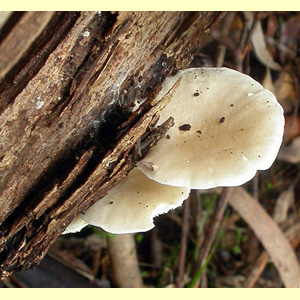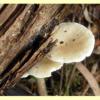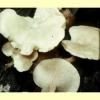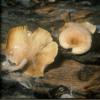
images/Clitocybe_semiocculta/Clitocybe_semiocculta_TM_DSCN8969.jpg
Small to medium (occasionally large) agaric, growing on wood or litter, with a white spore print. Fruit-body white to pale. Pileus not viscid. Lamellae adnate or subdecurrent, crowded. Stipe excentric or lateral, rarely central. Partial veil remnants absent. Spores hyaline, non-amyloid, smooth; germ pore absent. Cheilocystidia absent. Lamellar trama arrangement not known. Pileipellis a cutis. Clamp connections present.
This species is distinguished from other
Clitocybe by its occurrence on wood and the excentric stipe. Pale fruit bodies of
Panellus longinquus are similar in form but have a viscid pileus. The crowded lamellae distinguish
Clitocybe semiocculta from
Campanella (in which the lamellae are usually widely spaced and intervenose). In wood-inhabiting
Omphalotus and
Pleurotus, the pileus is often strongly coloured and the lamellae distinctly decurrent (
Omphalotus is also luminescent). The pileus of
Conchomyces is usually grey or brownish, but when pale, it can be distinguished by the spinose spores.
One species:
Clitocybe semiocculta. This is keyed out separately from other species of
Clitocybe because of its occurance on wood; all other Australian
Clitocybe grow on the ground or among litter. It also differs from most other
Clitocybe by usually having an excentric stipe.
Clitocybe semiocculta Cleland,
Trans. & Proc. Roy. Soc. S. Australia 51: 300 (1927).
W.A., S.A., N.S.W., Vic. and Tas. (and possibly also Qld).
In native forests.
On wood or bark, often on the underside of detached sheets of bark.
Saprotrophic.
Bougher, N.L. (2009a),
Fungi of the Perth region and beyond: a self-managed field book, Western Australian Naturalists' Club (Inc.), Perth. [
Description and
Illustration of
C. semiocculta]
Cole, F.M., Fuhrer, B.A. & Holland, A.A. (1984), A Field Guide to the Common Genera of Gilled Fungi in Australia, revised edn. Inkata Press, Melbourne. [Illustration of C. semiocculta]
Fuhrer, B. (2005), A Field Guide to Australian Fungi. Bloomings Books, Hawthorn. [Description and Illustration of C. semiocculta]
Fuhrer, B. & Robinson, R. (1992), Rainforest Fungi of Tasmania and South-east Australia. CSIRO Press, East Melbourne. [Illustration of C. semiocculta]
Grgurinovic, C.A. (1997a), Larger Fungi of South Australia. The Botanic Gardens of Adelaide and State Herbarium and The Flora and Fauna of South Australia Handbooks Committee, Adelaide. [Description and Microcharacters of C. semiocculta]
McCann, I.R. (2003), Australian Fungi Illustrated. Macdown Productions, Vermont. [Illustration of C. semiocculta]





